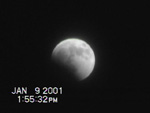
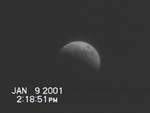
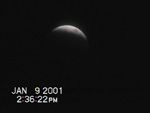
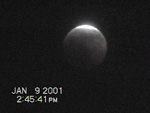
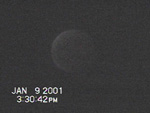
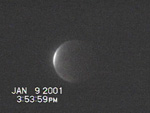
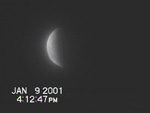
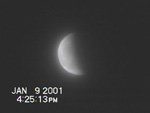
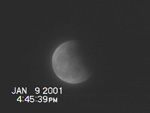
Eclipse Report
I viewed this first eclipse of the third millennium, a total lunar eclipse, from Elstree, UK, just to the northwest of London. Coincidence was in my favor for viewing this eclipse. I happened to be on travel to the UK for business, so I thought I would take the opportunity to attempt to see the eclipse. From my home in southern New Hampshire, USA, only the last partial phases of the lunar eclipse could be viewed just as the moon rose. For complete details on the lunar eclipse, please visit NASA/Fred Espanek - Total Lunar Eclipse of Jan. 9, 2001. Knowing the weather prospects were grim, I packed my equipment and brought it with me to the UK anyway. However, the weather that January evening in the greater London area proved to be satisfactory, with only periods of passing cloudiness. My equipment included my Celestron 5" Schmidt-Cassegrain Telescope (SCT) with Canon EOS Rebel G camera, loaded with Kodak Gold color print film (ISO 400). The SCT was mounted on a clock-driven equatorial mount. I replaced the stock counterweight that came with the mount with my Sony Digital8 DCR-TRV720 camcorder, so I also shot videoes of the eclipse.
From Elstree, the skies near the moon in the east were mostly clear as the moon approach the Earth's dark inner umbral shadow (U1 contact) at 18:42 local/UT. The deep penumbra of the moon was quite apparent on the lower limb of the moon before U1. The weather remained mostly clear, with just a passing cloud or two until just before totality (U2 - 19:50 local/UT), so I was able to take both photos and videos. Unfortunately, a few minutes before totality, heavy clouds moved in, and as the last bit of the moon was covered the Earth's shadow, the clouds started to spoil the show. During the 62 minutes of totality, I got many brief views of the reddish, orange moon through moderate to very thin cloud, lasting from a few seconds up to a minute. This made photography of totality virtually impossible with my f/10 scope, although I still tried. However, I did get some good video footage, which you can see below. Comparing to the two lunar eclipses in 1996 that I viewed, this one was darker. The red/orange coloring of the moon was quite apparent, with a brighter yellow area on the top limb of the moon (area closest to edge of umbra). My best estimate of the brightness of the moon during totality would be a Danjon value of 3. As totality ended (U3 - 20:52 local/UT), the clouds mostly cleared out, except for a very thin layer of almost transparent high cloud. It created a nice halo effect around the moon about 22 degrees in radius, which grew brighter as the moon moved out of the umbra. I was able to again take photographs and video footage of these partial phases until the eclipse ended. Once again, the penumbral shadow was obvious on the lower limb of the moon.
Overall, I'm quite satisfied with the view of the eclipse. Although it was cold (34° F / 1° C) and a bit cloudy, it still made for a memorable event.
Lunar Eclipse Photographs
All times in above video frames
are EST (UT - 5).
More video frames and photos will
appear here soon. Please check back!
You are visitor number
Please send comments about this page to Eric
Pauer. This page was last updated on 11 January 2001.